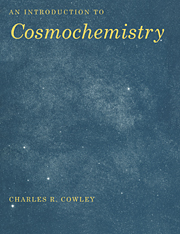Book contents
- Frontmatter
- Contents
- Foreword
- 1 Overview
- 2 Minerals: An Introduction to the Nomenclature and Chemistry
- 3 A Brief Introduction to Petrology
- 4 A Résumé of Thermodynamics and Statistical Mechanics
- 5 Condensation Sequences and the Geochemical Classification of the Elements
- 6 The Theory of the Bulk Composition of the Planets
- 7 Meteorites and the Standard Abundance Distribution (SAD)
- 8 An Introduction to Isotope Geology with an Emphasis on Meteorites
- 9 Some Concepts from Nuclear Physics
- 10 Energy Generation in Stars and Nucleosynthesis
- 11 Atomic and Molecular Spectra
- 12 The Analysis of Stellar Spectra
- 13 The Chemistry of Stars and Stellar Systems
- 14 Cold, Non-stellar Material in Galaxies
- 15 Emission-Line Regions and their Chemical Abundances
- 16 Abundances of the Elements in Galaxies
- Appendix
- References
- Index
14 - Cold, Non-stellar Material in Galaxies
Published online by Cambridge University Press: 05 June 2012
- Frontmatter
- Contents
- Foreword
- 1 Overview
- 2 Minerals: An Introduction to the Nomenclature and Chemistry
- 3 A Brief Introduction to Petrology
- 4 A Résumé of Thermodynamics and Statistical Mechanics
- 5 Condensation Sequences and the Geochemical Classification of the Elements
- 6 The Theory of the Bulk Composition of the Planets
- 7 Meteorites and the Standard Abundance Distribution (SAD)
- 8 An Introduction to Isotope Geology with an Emphasis on Meteorites
- 9 Some Concepts from Nuclear Physics
- 10 Energy Generation in Stars and Nucleosynthesis
- 11 Atomic and Molecular Spectra
- 12 The Analysis of Stellar Spectra
- 13 The Chemistry of Stars and Stellar Systems
- 14 Cold, Non-stellar Material in Galaxies
- 15 Emission-Line Regions and their Chemical Abundances
- 16 Abundances of the Elements in Galaxies
- Appendix
- References
- Index
Summary
Introduction
In 1910, the British astronomer Arthur Eddington published an influential monograph with the impressive title of Stellar Movements and the Structure of the Universe. Eddington, who became “The most distinguished astrophysicist of his time” (Chandrasekhar 1983), was only 28 when Stellar Movements was published, but his clarity of exposition and physical insight are readily seen in this small volume. Nevertheless, our present view of the Galaxy in which we live, and the universe around us, is completely different from that limned by Eddington at the end of the century's first decade. Not only were the astronomers of that time uncertain of the nature of the spiral nebulae we now call galaxies (Chapter 16), but they thought the solar system was at the center of our own system of stars.
It had been known since the time of the star gauges (counts) of William Herschel (1738–1822) that faint stars did not increase in number as one would expect, but indicated an “end” of the entire system. Today, at visual wavelengths we can in some sense detect the end of our Galaxy if we look out of the plane, toward its poles. Within the plane, starlight is significantly dimmed by interstellar material – by 1 to 2 magnitudes per kiloparsec (kpc) at visual wavelengths (§§13.3, 14.4).
If we merely count stars as a function of brightness, there is no way to distinguish between the effect of dust and an “end” of the stellar system.
- Type
- Chapter
- Information
- An Introduction to Cosmochemistry , pp. 315 - 358Publisher: Cambridge University PressPrint publication year: 1995



